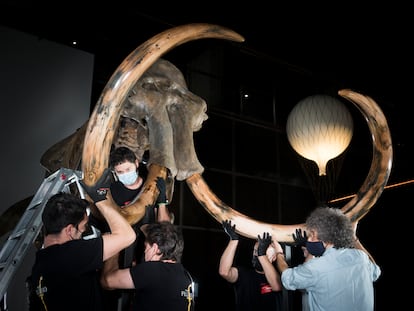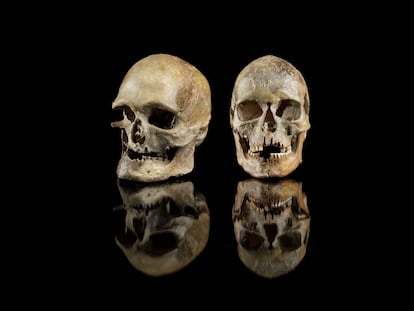Ben Lamm, founder of the first de-extinction firm: ‘We will have our first wooly mammoth by 2028’
The leader of Colossal assures that his technology will serve to recover ecosystems, but also to create artificial wombs for human embryos

Ben Lamm is the commercial face of de-extinction, a process that seeks to bring animals like the woolly mammoth, the Tasmanian tiger and the dodo bird back to life. Lamm, born in Austin, Texas, describes himself as a serial entrepreneur: just in the last decade, he has founded at least four successful technology startups. So why drop everything to pursue a dream that to some may seem straight out of science fiction?
From his home in California, Lamm explains by video call that what drives him the most is the idea of being able to restore ecosystems, discovering new technologies in the process. And he is more than just talk: Colossal, the firm he founded and directs to pursue this goal, has become the first large company in this new sector on a global level. His investors include personalities such as businesswoman Paris Hilton, Thomas Tull (the owner of the company that created the Jurassic Park franchise) and the Winklevoss twins (Facebook’s original investors). Thanks to this, he has already raised $75 million. He also counts among his ranks some prestigious geneticists from around the world like George Church and Beth Shapiro. Still, despite the support of these scientists, the million-dollar investments and the clear optimism he shows throughout the interview, many specialists question the viability of his claims.
Question. Where did the idea of cloning extinct animals as a business come from?
Answer. I’ve been really passionate about climate change, synthetic biology and genetic engineering. I think we could use this to solve many problems. So, I reached out to George Church, who is arguably the father of synthetic biology, and I asked him a bunch of questions about AI and computational biology for building software. Then I asked him, “George what else are you working on?” He said, “I’m working in de-extinction technology to bring back the mammoth and return it to the Arctic, as well as to apply those technologies to conservation.” I was enamored. After that I couldn’t stop thinking about it. I was running another company and I had to bring in a new CEO so I could pursue this.
Q. How did you convince other people that this was a viable project?
A. What’s amazing about what we are building is that when we look at bringing back an extinct animal, it’s really a systems problem. You have to build a whole system that helps you analyze genomes. You have to build and improve the technology that allows you to edit genes and to actually synthesize genes. And then you have to build assisted reproduction technologies. It’s like the Apollo program: going to the Moon. Also crazy and weird, right? So that’s the way I took it to our big investors. I explained to them that in the way to de-extinction we were going to innovate in all these other areas that have massive applications.
Q. Could we say then that de-extinction is an excuse to look for new technologies?
A. I don’t know if “excuse” is the right word. I would say it’s an opportunity. Just to be clear, if we built all these technologies but we are not successful in the de-extinction effort, I won’t consider it successful. We are making tremendous strides. All of the projects that we are working on are on track, but we have to achieve both.
Q. What will you do as a company once you achieve de-extinction?
A. I think there are massive applications around carbon credits [financial instruments devised to reduce emissions]. Biodiversity is our best combatant against climate change and to protect ecosystems. So with that, I think there will be billions of dollars in opportunities around carbon credits and biodiversity credits in the things that we are building.

Q. What could go wrong with this technology?
A. You need to be thoughtful any time you do anything with new technologies, and when you are doing anything that is big and bold. You need to be transparent. You need to be clear. You need to have the right team around, that knows what they are doing. You have to be ethical. We have a team for that. I think the right use of this is for the conservation of keystone species that mankind had a role in their eradication, like mammoths or elephants. Their reproductive cycle is too long and you have to have a large number of them to keep the population.
Just to be clear, you cannot de-extinct a dinosaur like in Jurassic Park [laughs]. It is not possible. There is no DNA. There are amino acids but there’s no DNA. Bringing back mammoths is possible; bringing back dinosaurs is not.
Q. But you are trying to bring extinct species back into the wild. Don’t you think that this can also have negative consequences?
A. That’s a really good point. We are actually using these de-extinction projects to help fix and bring back stability to degraded ecosystems. The introduction by humans of invasive species is what caused the extinction of the dodo. We will work with the governments when the moment arrives to rewild them. We promise that these ecosystems can thrive from the reintegration of the species.
Q. Do you think that any of the technologies that you are developing could be useful to medicine?
A. All of the gene editing tools that we are working with have huge applications for human healthcare, for gene therapy. Also, we are working on artificial wombs. I’m very excited by that because I think it is massive for conservation. If you could grow a hundred white rhinos in a lab and then reintroduce them back into the wild, that would be incredible; it could also be great for human embryos and IVF (in vitro fertilization).
Q. What is on the horizon for the next few years?
A. Hopefully, in some years we’ve not only successfully brought back the mammoth and the dodo, but we’ve successfully rewilded them. Maybe we will be working on another species. I hope that we’ve shown the applications for conservation.
Q. So when will we have the first mammoths?
A. Our goal, and we feel pretty confident about it, is that we will have our first wooly mammoth by 2028.
Sign up for our weekly newsletter to get more English-language news coverage from EL PAÍS USA Edition
Tu suscripción se está usando en otro dispositivo
¿Quieres añadir otro usuario a tu suscripción?
Si continúas leyendo en este dispositivo, no se podrá leer en el otro.
FlechaTu suscripción se está usando en otro dispositivo y solo puedes acceder a EL PAÍS desde un dispositivo a la vez.
Si quieres compartir tu cuenta, cambia tu suscripción a la modalidad Premium, así podrás añadir otro usuario. Cada uno accederá con su propia cuenta de email, lo que os permitirá personalizar vuestra experiencia en EL PAÍS.
¿Tienes una suscripción de empresa? Accede aquí para contratar más cuentas.
En el caso de no saber quién está usando tu cuenta, te recomendamos cambiar tu contraseña aquí.
Si decides continuar compartiendo tu cuenta, este mensaje se mostrará en tu dispositivo y en el de la otra persona que está usando tu cuenta de forma indefinida, afectando a tu experiencia de lectura. Puedes consultar aquí los términos y condiciones de la suscripción digital.
More information
Últimas noticias
Most viewed
- Reinhard Genzel, Nobel laureate in physics: ‘One-minute videos will never give you the truth’
- Oona Chaplin: ‘I told James Cameron that I was living in a treehouse and starting a permaculture project with a friend’
- Pablo Escobar’s hippos: A serious environmental problem, 40 years on
- Why we lost the habit of sleeping in two segments and how that changed our sense of time
- The fall of a prolific science journal exposes the billion-dollar profits of scientific publishing











































